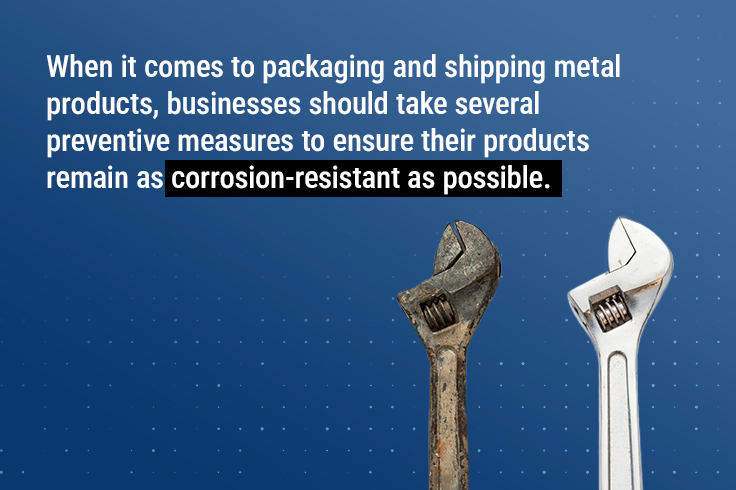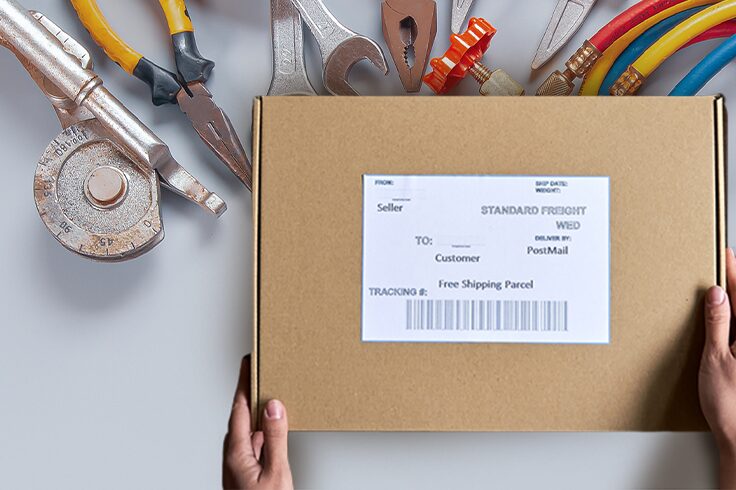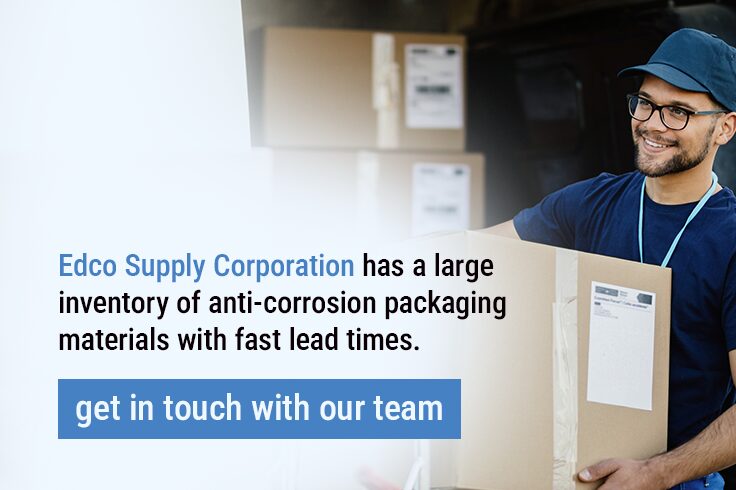Do you often ship metal products? If so, you may be concerned about whether your items will arrive without showing signs of corrosion. Corrosion affects the quality and integrity of meta, and dealing with corrosion can result in delivery delays, extra maintenance costs and dissatisfied customers.
Unprotected metals can deteriorate during transit when exposed to certain environmental factors. Exposure to moisture or humidity can lead to rust, tarnishing and structural damage. To learn how to protect packaged metals from corrosion, we’ll discuss what exactly corrosion is, the factors that lead to corrosion and the different kinds of corrosion.
What Is Corrosion?
Although corrosion can happen to any material, corrosion is most well known for its effect on metallic materials. Corrosion is a natural process that weathers all types of metal in one way or another. When some metals react with their environments, they deteriorate or get weaker over time, making them less effective or even unsafe to use.
At its core, metal corrosion converts metal back to a more chemically stable form, such as oxide, hydroxide or sulfate, through an electrochemical reaction. Oxidation is one of the most common causes of corrosion — the majority of metals are susceptible to losing electrons to oxygen and other kinds of substances, which causes oxidation. Once metal reacts with a substance such as water or air, oxidation occurs, and corrosion can be a result of oxidation.
Corrosion can cause dangerous and costly problems, such as:
- Collapsing buildings and bridges
- Pipeline breaks
- Chemical plant leaks
- Flooding bathrooms
- Electrical fires
- Blood poisoning
- Damaged art
What Factors Influence Corrosion?
Here are the most common factors that influence metal corrosion:
- Humidity: Humidity creates moist conditions for chemical reactions to occur on metal surfaces.
- Temperature: Higher temperatures often increase the rate of corrosion by speeding up chemical reactions.
- pH levels: The more acidic the environment, the more hydrogen ions form hydrogen gas, which corrodes metals like steel rapidly.
- Electrolytes: Electrolytes like saltwater, acid and industrial chemicals can react with metals or enhance their conductivity, which leads to a faster corrosion process.
- Electricity: Exposure to electric currents expedites the corrosion process in most metals.
- Oxygen: Oxygen can cause metals to corrode through oxidation.
Do All Metals Corrode?
All metals have the potential to corrode. However, some metals corrode more slowly than others, depending on their type and environmental condition.
Most metals are processed from minerals or ores into metals, which are more unstable than their natural forms. In comparison, copper and noble metals — palladium, silver, gold and platinum — are present in nature in their purest forms. Although these metals mostly remain unaffected by typical corrosion factors, they can corrode under extreme conditions.
Other types of metal that are more resistant to corrosion include:
- Stainless steel: Stainless steel contains a high percentage of chromium. Chromium oxidizes and forms a thin layer of chromium oxide on the metal surface, which is corrosion-resistant.
- Aluminum: When water comes in contact with this metal, aluminum oxide forms, making it even more corrosion-resistant.
- Bronze: This metal contains a mixture of copper and tin with a small amount of other elements, making it more corrosion-resistant than many other metals.
- Galvanized steel: Galvanized steel is coated with a thin layer of zinc that acts as a barrier to oxygen and water, providing advanced protection against corrosion.
What Are the Different Types of Corrosion?
Metals can be exposed to the following different types of corrosion:
- General attack corrosion: Also known as uniform corrosion, this common form of corrosion affects the whole surface of a metal structure and is usually caused by chemical or electrochemical reactions. It’s usually easier to prevent and manage this type of corrosion.
- Localized corrosion: Localized corrosion is an umbrella term that describes any form of corrosion that affects only specific areas.
- Galvanic corrosion: This type of corrosion happens when two different metals make contact in a corrosive electrolyte, like salt water. An electric current flows between the two metals, resulting in the corrosion of the most electronegative of the two metals.
- Pitting corrosion: Pitting is localized corrosion that results in holes or cavities in metal.
- Environmental cracking: Environmental, chemical and stress-related conditions result in the environmental cracking of metals.
- Crevice corrosion: Another type of localized corrosion, crevice corrosion usually occurs in stagnant water at metal joints.
- Fretting corrosion: Repeated weight, vibrations or wearing cause corrosion that shows pits and grooves on the metal surface. This often happens in moving machine parts.
- Filiform corrosion: Filiform, which is also a form of localized corrosion, occurs under painter or plated surfaces where oxygen and moisture permeate.
- High-temperature corrosion: Oxidization, sulfidation and carbonization can cause high-temperature corrosion, even on metals that can normally withstand corrosion and high temperatures.
- Soil corrosion: The higher the moisture content, electrical conductivity, acidity levels and electrolyte levels, the more likely a metal surrounded by soil will corrode.
How Do You Protect Metals in Packaging From Corrosion?
When it comes to packaging and shipping metal products, businesses should take several preventive measures to ensure their products remain as corrosion-resistant as possible.

Add a Protective Coat
Applying certain substances can slow down the corrosion process on metallic products.
- Oil coating: Oil acts as both a lubricant and a protective barrier against corrosion. However, applying it takes time and energy as it has to be done repeatedly.
- Dry coating: Similar to oil, dry coating creates a protective barrier against corrosion and rust, but without the oily residue.
- Paint: Using the right type of oil-based paint that sticks to metal is a cost-effective way to help slow down the corrosion process while giving the metal object a different color or finish.
- Galvanizing: Galvanizing involves applying a protective coating of zinc, which corrodes more slowly than other metals. The downside is that this protective layer changes the appearance of metals and components.
- Powder coating: Powder coating is a powdery substance, often made from acrylic, epoxy, polyester or polyurethane. It binds to a metal object through static electricity and is then melted in a furnace to form a solid, uniform layer.
Create a Controlled Packaging Environment
Another way to prevent corrosion to metal products is to adjust your packaging environment and procedures. You can follow these tips for all types of packaging and products:
- Wear gloves: Bare hands may be a source of contaminants that could cause metal corrosion. Use clean gloves when handling metal products and switch them out regularly when they become wet or dirty.
- Pack clean products: Metal products need to be dry and clean of residues before they’re packed.
- Pack at room temperature: Humidity can create condensation on metal surfaces when it cools down. Before packing metal items, wait until they’re at room temperature.
- Close packages tightly: Ensure packages are folded and sealed tightly to prevent water or moisture from entering them.
- Be careful of other materials: Any pallets or containers made of wood or cardboard may contain moisture or contaminants that could contribute to corrosion. Keep metal products away from other materials or add a protective layer before placing them on different materials.
Use Anti-Corrosion Packaging
Some anti-corrosion packaging options include:
- Volatile corrosion inhibitor (VCI) packaging: VCI packaging is a protective packing material that creates an enclosed environment to provide protection against corrosion. VCI packaging is easy to use, cost-effective and environmentally friendly.
- Desiccants: These hygroscopic substances attract and absorb moisture from the air to keep the environment around metal products dry. Desiccants remove water in two ways — either by absorbing the moisture directly or through chemical reactions.
- Moisture barrier bags: Also called vapor barrier bags, this type of packaging material prevents condensation and movement of water vapors so no moisture collects on products. Moisture barrier bags protect items from humidity, oxygen and grease to prolong the shelf life and prevent spoilage.
Prevent Corrosion During Shipments With Edco
It’s important to use packaging material that will help protect metal products and prolong their shelf life in storage and transit. Fortunately, different types of corrosion protection materials exist.
Edco Supply Corporation has a large inventory of anti-corrosion packaging materials with fast lead times. We’re the world’s leading supplier of military specification packaging serving industrial and commercial industries.
Browse our protective packaging product lines or get in touch with our team for more information on how to prevent corrosion on your products.



